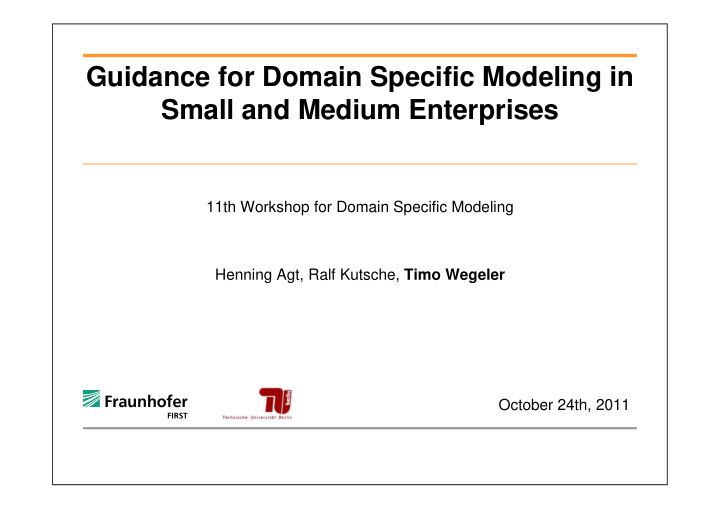



Guidance for Domain Specific Modeling in Small and Medium Enterprises 11th Workshop for Domain Specific Modeling Henning Agt, Ralf Kutsche, Timo Wegeler October 24th, 2011
Outline � Project Context � Partner Survey � Guidance for Modeling � Guidance for DSL design � Conclusions and Outlook Page 2
Outline � Project Context � Partner Survey � Guidance for Modeling � Guidance for DSL design � Conclusions and Outlook Page 3
Project Context: The „BIZWARE“ Project •Duration: 09/2010 – 08/2013, Budget € 11.5M, Funding € 6.5M •2 academic, 8 industrial partners from Berlin •4 joint projects with 17 sub-projects and 6 single projects •Develop a systematic approach to DSL engineering for small and medium enterprises BIZWARE http://www.bizware.org Page 4
Outline � Project Context � Partner Survey � Guidance for Modeling � Guidance for DSL design � Conclusions and Outlook Page 5
Partner Survey: Perceived & Demanded Benefits of DSM • interviews conducted with the industrial partners • domains: • health care • finance • publishing • facility management • industrial production • web application development • system integration • motivation for investing into a DSL development • identify challenges • individual and systematical Page 6
Partner Survey: Perceived & Demanded Benefits of DSM • categorize DSL developments • vertical (business) vs. horizontal (technical) • to be used by partners vs. their end customers • requirements and challenges for the engineering process • interview pattern used • standards used within the domain • software engineering standards used at the partner • what is currently being modeled, and how • project goals • purpose of the DSLs and future modeling • perspective users of the DSLs • examples provided • requirements identified Page 7
Partner Survey Results: Motivation • need to abstract from implementation details • ease the software development process • to be able to systematically involve customers and end users • overcome discontinuity in requirements, design and specification documents and artifacts • to use design artifacts as first class development artifacts, without interrupting refinement processes • to improve documentation • to ease the software configuration • ease deployment on different target platforms Page 8
Partner Survey Results: Benefits • better documentation already is achieved during DSL development • effort reduction • higher levels of abstraction • improvement of development processes and their organizational aspects • improved internal and external communication • leverage existing documents • integrate into existing development landscape • overcome business/technical view mismatches Page 9
Partner Survey Results: Challenges • methodological support required (guidance) • difficulty in measuring design effort and communication benefits • versioning and consistency preservation • tool evaluation required Page 10
Outline � Project Context � Partner Survey � Guidance for Modeling � Guidance for DSL design � Conclusions and Outlook Page 11
Guidance for Modeling (2) (3) extract terms create and and relations execute queries Domain Model Word-net Q u develops e r Extractor y DSL (1) Engineer W ... r Model Advisor a p interacts p with e r DB-pedia provide integrate model results Semantic suggestions Knowledge Bases Domain Guidance (5) (4) Page 12
Guidance for Modeling Abstract Syntax Model Refinement Language Workbench Model Knowledge EXAMINE Suggestions Bases Modeling Knowledge System Domain Guidance Acquisition Text Exploration Model Extractor Advisor Page 13
Guidance for Modeling: Example Page 14
Guidance for Modeling • generated guidance model from existing knowledge sources • assistance to overcome problems: • completeness • correctness • not automatically added • brain power still required • then use feedback from domain expert Page 15
Outline � Project Context � Partner Survey � Guidance for Modeling � Guidance for DSL design � Conclusions and Outlook Page 16
Guidance for DSL design Framework for D omain- I mpelled E ngineering and S upervised E volution of L anguages Page 17
Guidance for DSL Design • identify concepts required and used in the DSL • survey domain expert’s associations of common symbols or concepts in a questionnaire • to assess concepts known to the user of the DSL • identify possible syntaxes considering the assessment and the required expressivity • test user acceptance of proposed syntaxes • make a selection of the best approaches • provide metrics support • perform the next step of DSL rapid prototype implementation Page 18
Outline � Project Context � Partner Survey � Guidance for Modeling � Guidance for DSL design � Conclusions and Outlook Page 19
Conclusions and Outlook • let DSL engineering processes benefit from the use of knowledge bases and metrics • novel features required for better adoption of domain specific modeling in small and medium enterprises (SME) • lower the entry barrier • supply guidance to both DSL engineer and domain expert • guidance for when using the DSL Page 20
Thank you for your attention • ?‘s • !‘s Page 21
Recommend
More recommend